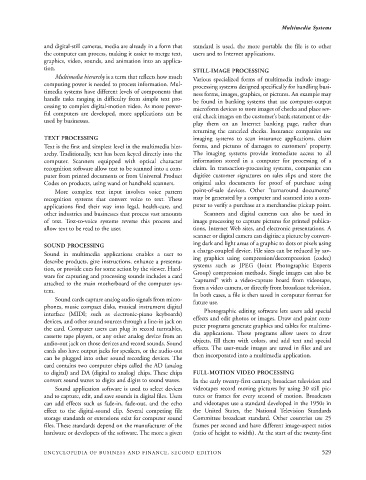Page 552 - Encyclopedia of Business and Finance
P. 552
eobf_M 7/5/06 3:15 PM Page 529
Multimedia Systems
and digital-still cameras, media are already in a form that standard is used, the more portable the file is to other
the computer can process, making it easier to merge text, users and to Internet applications.
graphics, video, sounds, and animation into an applica-
tion.
STILL-IMAGE PROCESSING
Multimedia hierarchy is a term that reflects how much
Various specialized forms of multimedia include image-
computing power is needed to process information. Mul-
processing systems designed specifically for handling busi-
timedia systems have different levels of components that
ness forms, images, graphics, or pictures. An example may
handle tasks ranging in difficulty from simple text pro- be found in banking systems that use computer-output
cessing to complex digital-motion video. As more power- microform devices to store images of checks and place sev-
ful computers are developed, more applications can be
eral check images on the customer’s bank statement or dis-
used by businesses.
play them on an Internet banking page, rather than
returning the canceled checks. Insurance companies use
TEXT PROCESSING imaging systems to scan insurance applications, claim
Text is the first and simplest level in the multimedia hier- forms, and pictures of damages to customers’ property.
archy. Traditionally, text has been keyed directly into the The imaging systems provide immediate access to all
computer. Scanners equipped with optical character information stored in a computer for processing of a
recognition software allow text to be scanned into a com- claim. In transaction-processing systems, companies can
puter from printed documents or from Universal Product digitize customer signatures on sales slips and store the
Codes on products, using wand or handheld scanners. original sales documents for proof of purchase using
More complex text input involves voice pattern point-of-sale devices. Other “turnaround documents”
recognition systems that convert voice to text. These may be generated by a computer and scanned into a com-
applications find their way into legal, health-care, and puter to verify a purchase at a merchandise pickup point.
other industries and businesses that process vast amounts Scanners and digital cameras can also be used in
of text. Text-to-voice systems reverse this process and image processing to capture pictures for printed publica-
allow text to be read to the user. tions, Internet Web sites, and electronic presentations. A
scanner or digital camera can digitize a picture by convert-
ing dark and light areas of a graphic to dots or pixels using
SOUND PROCESSING
a charge-coupled device. File sizes can be reduced by sav-
Sound in multimedia applications enables a user to ing graphics using compression/decompression (codec)
describe products, give instructions, enhance a presenta-
systems such as JPEG (Joint Photographic Experts
tion, or provide cues for some action by the viewer. Hard-
ware for capturing and processing sounds includes a card Group) compression methods. Single images can also be
attached to the main motherboard of the computer sys- “captured” with a video-capture board from videotape,
tem. from a video camera, or directly from broadcast television.
In both cases, a file is then saved in computer format for
Sound cards capture analog audio signals from micro-
future use.
phones, music compact disks, musical instrument digital
Photographic editing software lets users add special
interface (MIDI; such as electronic-piano keyboards)
effects and edit photos or images. Draw and paint com-
devices, and other sound sources through a line-in jack on
the card. Computer users can plug in record turntables, puter programs generate graphics and tables for multime-
cassette tape players, or any other analog device from an dia applications. These programs allow users to draw
audio-out jack on those devices and record sounds. Sound objects, fill them with colors, and add text and special
effects. The user-made images are saved in files and are
cards also have output jacks for speakers, or the audio-out
then incorporated into a multimedia application.
can be plugged into other sound recording devices. The
card contains two computer chips called the AD (analog
to digital) and DA (digital to analog) chips. These chips FULL-MOTION VIDEO PROCESSING
convert sound waves to digits and digits to sound waves. In the early twenty-first century, broadcast television and
Sound application software is used to select devices videotapes record moving pictures by using 30 still pic-
and to capture, edit, and save sounds in digital files. Users tures or frames for every second of motion. Broadcasts
can add effects such as fade-in, fade-out, and the echo and videotapes use a standard developed in the 1950s in
effect to the digital-sound clip. Several competing file the United States, the National Television Standards
storage standards or extensions exist for computer sound Committee broadcast standard. Other countries use 25
files. These standards depend on the manufacturer of the frames per second and have different image-aspect ratios
hardware or developers of the software. The more a given (ratio of height to width). At the start of the twenty-first
ENCYCLOPEDIA OF BUSINESS AND FINANCE, SECOND EDITION 529

